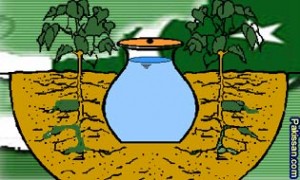In the arid southern Sindh province in Pakistan, farmers are employing an ancient technique of drip irrigation to what they call miraculous effect. An article this week from the Christian Science Monitor is a fresh reminder of how even low-tech ingenuity can bring life in the form of fresh vegetables to farmers dealing with climate change and drought around the world.
 For 34-year-old Soomar in Pakistan, plants are growing where before there was only sand, with the region receiving only about five inches of rain a year. Pitcher irrigation—where porous clay pots are buried to seep water to the roots of plants directly—has provided a fresh source of income for more than 200 families who previously thought it impossible to farm vegetables on these dry lands, according to the article.
For 34-year-old Soomar in Pakistan, plants are growing where before there was only sand, with the region receiving only about five inches of rain a year. Pitcher irrigation—where porous clay pots are buried to seep water to the roots of plants directly—has provided a fresh source of income for more than 200 families who previously thought it impossible to farm vegetables on these dry lands, according to the article.
"All we did was plant pitchers [in the soil] and sow different vegetable seeds, and it feels as if the vegetables are growing on their own," Soomar said. He buried 20 pitchers on the land outside his hut near Chotiari freshwater reservoir.
The method is ideal for sandy to loamy soil with good porosity.
Saleh Mangrio, executive director of the Pakistan-based Center for Rural Change, has conducted successful experiments with pitcher irrigation at the community level in Sindh’s eastern desert under a project funded by the Dutch government and managed by the World Wide Fund for Nature-Pakistan.
The rate of water seepage from a pitcher depends on the type of plant and soil, and climatic conditions, he explains. Once the surrounding soil becomes saturated, water will soak back into the pot, filling it again. “The system is self-regulating and water losses are negligible,” he says in the article.
For more information on how you can put together your own pitcher irrigation system, check out these site from Michigan Technological University and howtopedia.org.